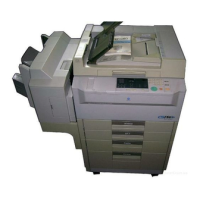10
2
3
4
5
1
9
13
12
11 8 7
MANUAL BYPASS
TABLE
6
1. PC DRUM
2. DRUM CHARGING
3. UNEXPOSED AREAS/EDGE ERASE
4. EXPOSURE
5. DEVELOPING
6. PAPER FEEDING
7. IMAGE TRANSFER
8. PAPER SEPARATION
9. CLEANING
10. MAIN ERASE
11. TRANSPORT
12. FUSING
13. PAPER EXIT
2
COPY PROCESS
1. PC Drum
The PC Drum is an aluminum cylinder coated with a photosensitive semiconductor.
It is used as the medium on which a visible developed image of the original is
formed.
(For more details, see p. M-10.)
2. Drum Charging
The PC Drum Charge Corona Unit is equipped with a Comb Electrode and a
Scorotron Grid to deposit a uniform negative charge across the entire surface of the
PC Drum.
(For more details, see p. M-30.)
3. Unexposed Areas/Edge Erase
Any areas of charge which are not to be developed are neutralized by lighting up
LEDs.
(For more details, see p. M-31.)
4. Exposure
Light from the Exposure Lamp reflected off the original is guided to the surface of
the PC Drum and reduces the level of the negative charges, thereby forming an
electrostatic latent image.
(For more details, see p. M-34.)
5. Developing
Toner positively charged in the Developer Mixing Chamber is attracted onto the
electrostatic latent image changing it to a visible, developed image. A DC negative
bias voltage is applied to the Sleeve/Magnet Roller to prevent toner from being
attracted onto those areas of the PC Drum which correspond to the background
areas of the original.
(For more details, see p. M-16.)
M-2

